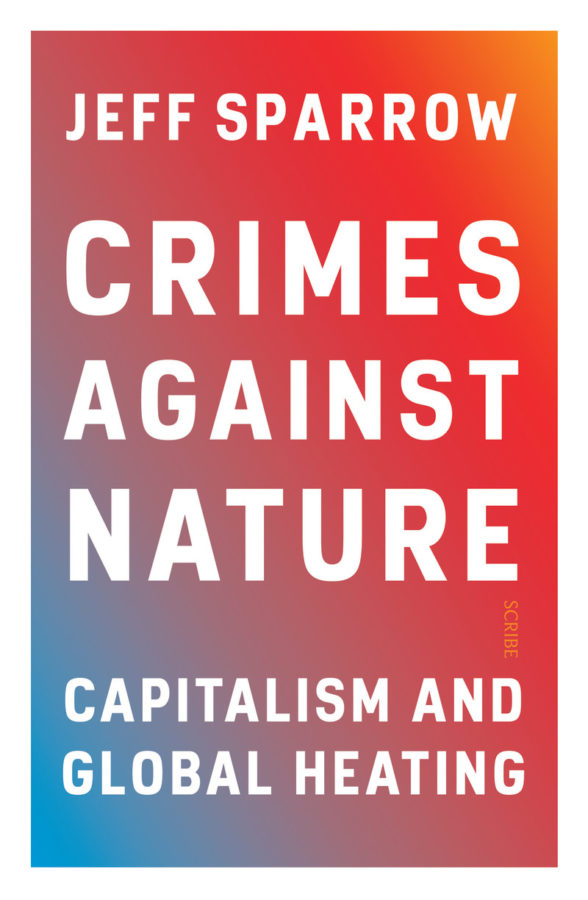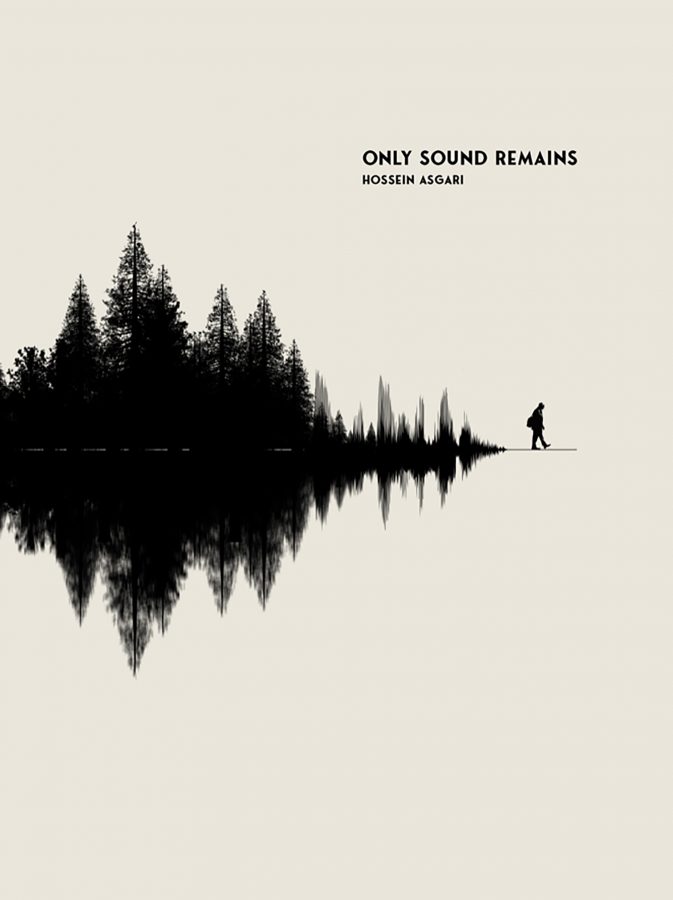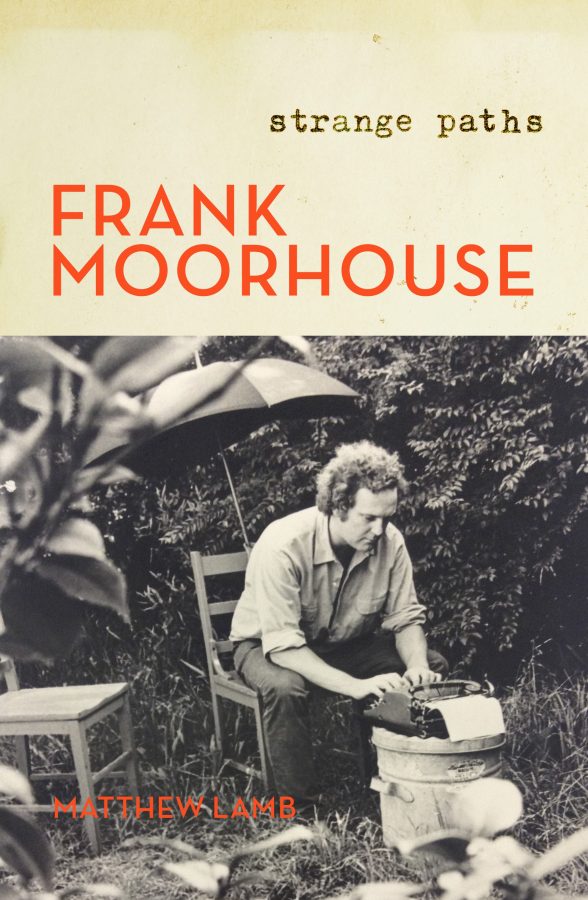The recent mainstreaming of political progressivism has brought with it a new subculture of personal branding, corporate partnerships, and uninhibited careerism, and with this the unmistakable feature of contemporary political discourse: a totalised splitting into categories of right and wrong, good and bad, damned and saved. Among this Jeff Sparrow has been an anchor of integrity and considered optimism. He trusts in the potential for good in humanity, and, while keenly aware of the threat posed by the growth of far-right movements, he does not sneer at or fear the politicisation of the ‘unenlightened’ masses.
This difference between Sparrow and many other progressive commentators has been demonstrated recently in his nuanced coverage of pandemic politics, of the left assent to hyperinflated surveillance and policing power, and the class-element that comes embedded in Covid-19 policy responses. He clearly retains a strong belief that minds can be changed through engagement, empathy, well-reasoned argumentation, and, most importantly, material support for people’s wellbeing.
Sparrow writes in a clear, unpretentious, manner about complex issues. As a result general readers are able to engage with his work, and be opened up to new, different, and in many cases heightened, ways of viewing the world. By my estimation, Sparrow is the most effective and consistent communicator of left-wing thought to a mainstream Australian audience of the past twenty years. His writing is always undergirded by a serious understanding of the interlinkages of history, economy, and society. The rigour of Sparrow’s political commentary doubtless owes a debt to his long study of Marxist thought, but sharing his ideological and political beliefs is not a requirement for appreciating the depth and quality of his work.
I speak of Sparrow’s politics directly because Crimes Against Nature is an overtly socialist book. The solutions to the crises of our age that he offers are explicit on this point. Sparrow wants a planned economy, rooted in organic, organised, mass movements, with ecological wellbeing at its heart. Not liberal market-based reforms, ‘green technology’, tax credits, or carbon-offsets.
In Crimes Against Nature, Sparrow confronts the liberal delusion that we can simply tweak our way out of environmental crisis. He prescribes a pill that is far more difficult to swallow: to avert manmade ecological catastrophe on an unprecedented scale, we must radically change the way we live, work, consume, and organise ourselves economically. An argument for such radical social transformation requires a compelling case for why the system as it stands cannot deliver us from ruination. This book is Sparrow’s explanation of how ecocide is built into the structure of capitalism, and why the only way to divert ourselves from the worst path of ecological destruction is by abandoning capitalism, as an economic system and an ideology that governs how we live.
It is a monumental task. And it is one made all the more difficult because Sparrow is, self-consciously, seeking to do this in a way that is both intelligible and enjoyable for the non-expert. This goal has, I think, influenced to a great extent not just the content but the form of the book.
Crimes Against Nature is not a linear inquiry into the relationship between capitalism and global heating, but rather a collection of essays, presented as chapters, on the theme. While there is some inter-reference between the chapters, each could easily stand alone and remain perfectly comprehensible without having read what preceded it. This is a clear strength for a book that is written to be able to be picked up and put down, or serve as a reference point for any of the dozen or so discrete areas that Sparrow has selected to serve his argument for radical political and economic change in the face of environmental crisis.
The approach does, however, come with a certain cost for the coherent chronological and thematic advancement of the narrative and argument. The reader jumps backward and forward in time, and to and fro in space, with what can feel at times to be jarring rapidity. Themes emerge and re-emerge in separate chapters, with centuries and continents in between, that would have more naturally been addressed together. (Chapters three and nine, both grappling with Indigenous methods of social organisation and environmental management and the impact of colonialism and capitalism, but separated by one hundred pages of other discussion, present the clearest example of this.)
The central thesis of the book is laid out directly in the introduction: ecological destruction and climate change are not a result of humanity’s collective greed and innate failings, but the consequence of capitalism, an historically contingent set of social and political structures, run by a small elite for their own benefit against the interests of the majority. Most importantly, the strictures and norms of capitalism were not produced through an organic and voluntary democratic process, but rather they came into existence without the assent of the majority, and relied on overt violence and covert influence campaigns to achieve power and maintain a functional level of consent.
Sparrow’s message to the reader is unequivocal: ‘you’re living through some of the most significant years in human history, with the decisions made in a desperately brief span weighing on the planet forever’. By demonstrating how climate catastrophe is caused by capitalism, not by the failing of humanity as a whole, Sparrow hopes to break through the growing sense of disempowered hopelessness, and rally his audience around a vision of a better world.
A work of this scope and structure necessitates a clear and detailed introduction, which will map out the contours of the historical, cultural, economic, and ecological landscape that we are to traverse, and provide a unifying framework through which the reader can place the vast and varied terrain of the book. The introduction to Crimes Against Nature clearly frames the ‘guilty party’ behind climate crisis, but is low on detail. We are given less than three pages of context to set the scene for the thirteen essays to follow.
The first essay of the collection introduces us to several themes that run through the book: the conflict between private and public interest, technology’s social impact, and the power of capitalism to physically reshape the world. It does so through an investigation of the nefarious methods by which industrialists, ad-men, and lobbyists, in cooperation with lawmakers, came to reshape the urban environment around perhaps the most ubiquitous consumer item of the twentieth century: the automobile. The story of the personal automobile told by Sparrow stands in stark contrast to that which has been enshrined in Western, and particularly American, culture for the past century; the car as the great emancipator for individual freedom of movement, and the consumer icon par excellence of status and personal identity for the everyman.
In the early decades of its production, the car was unmistakably an object for the wealthy few. Simmering informal campaigns of sabotage against car owners, and political wariness over the rumblings of the discontentment of the masses during the first decades of the twentieth century, demonstrate the impact that the adoption of automobiles was having on the urban landscape, and the sense of safety and common right to the use of space by normal people in environments that were quickly being overtaken by cars.
Utilising well-chosen anecdotes and historical vignettes, Sparrow shows how, over the course of the twentieth century, public money to the tune of billions of dollars was used to reshape the United States with the roads, bridges, interchanges, tunnels, and myriad other pieces of infrastructure needed for cars to come to supersede rail, carriage, and canal as the dominant mode of personal transport. The cleaner, cheaper, and more egalitarian systems of public transport were largely done away with as a result of the redirection of public resources towards supporting the politically influential automotive industry.
The destruction wrought by the automobile is not only measured in environmental cost, or blighted vistas of endless highway interchange, but in the social fabric of American life. In a particularly poignant paragraph, Sparrow tells of how the car’s facilitation of further and faster travel also made that travel mandatory:
Greater speeds became possible, but people spent more time travelling, with the car suddenly necessary for the simplest activity… since in a home physically distant from others, the individual (or the individual family) became responsible for feeding, washing, and entertaining themselves in isolation.
This situation points to a larger issue with humanity’s use of technology, one that has been prominent among historians and theorists of the relationship between man and machine, like Marshall McLuhan and Lewis Mumford, for many years; we do not necessarily bend technology to our needs, but rather technology reshapes us and the way we live. Under capitalism, this arc always bends towards market growth, increased consumption, and fatter profits, regardless of the effects on the natural world, or even on the health and wellbeing of people, and their ability to live together convivially.
With automobiles, we restructured our lives away from communities with work, family, social and cultural life all close at hand, to sprawling atomised, suburban homes. With this first essay Sparrow brings forth a key argument, that technological, economic, and social ‘progress’, as defined under a capitalist framework, is a threat to both human and ecological flourishing.
With the second essay, Sparrow moves into another major theme of his book, showing how the responsibility for the rapacious environmental destruction wrought by socio-economic orders orchestrated by, and working in the interests of, a small corporate and political-managerial elite, is transposed as a moral failing of humanity as a whole. This leads to an understanding of a sort of ingrained oppositional dynamic between man and nature, whereby humanity stands outside of nature, and, driven by the base instincts of consumeristic lust and cupidity, will necessarily see to its destruction.
Sparrow’s stance against this understanding of humanity is maintained throughout the book. He uses examples of Indigenous and pre-modern societies to demonstrate that avarice is not in fact the immutable reality of the human condition, but rather, in its current industrial and institutionalised form, the result of one specific social formation: capitalism. Other modes of social organisation exist, ones which do not set humans in opposition to an idealised nature, and have not resulted in wholesale ecological catastrophe.
Indigenous writers and thinkers have themselves long grappled with the root cause of colonialist greed and wanton ecological devastation, and it would have strengthened the book to have sought out connections and complementarities with some of this literature. One useful example immediately springs to mind: in Columbus and Other Cannibals, Jack D. Forbes articulates a particularly potent Native American understanding of the ‘wetiko’ sickness, a psycho-spiritual affliction that promotes the ‘the consuming of another’s life for one’s own private purpose or profit’, as having driven the white colonisers’ orgy of destruction. Wetiko can exist in any place and any time, but it is in capitalism that the drive to commodify, exploit, and consume every piece of the earth, and now every aspect of our social relations, for profit finds its political-economic realisation.
Praise for Indigenous models of humanity living as part of nature, as opposed to dominating it, is uncontroversial in progressive spheres. But Sparrow does something with the idea that is vital if a challenge is to be successfully mounted against the liberal, technocratic, mandate for a ‘green capitalist’ solution to climate crisis that is coming to predominate in what passes for climate action on the world stage. He delves into the history of the formation of capitalism in the West to show that, here too, more sustainable modes of life and ways of relating to other people and the living environment in which society was immersed, existed and thrived in the pre-modern era. For capitalism to reign supreme, these alternatives to capitalism had to be subverted and destroyed just as thoroughly in the West itself as in the colonised world.
The overall thrust of transforming diverse modes of living and relating to the world into a homogeneous market ripe for efficient industrial organisation and exploitation was remarkably similar in both the core and periphery of the capitalist world. This is true despite the fact that this transformation was conducted with different methods and different levels of brutality and coercion, largely determined by the race and power to resist of the oppressed. Sparrow raises the enclosure of the commons as a necessary step in pushing subsistence farmers into the satanic mills of industrial England, and illustrates a compelling link between this process and the colonisation of Australia:
By a grotesque irony, the dispossession of Indigenous people in Australia can be traced to a similar dispossession in England itself, with the settlement of the new country, driven, at least, in part, by the need to rebuild a different order in the old one.
It is an observation that is reminiscent of a major theme in Karl Polanyi’s 1944 The Great Transformation. He argued that the modus operandi of capitalism, the smashing up of social structures in order to extract profit, had operated in eighteenth-century England in much the same way as it did in British colonial domains. In England this was overwhelmingly done for the purpose of forcing the peasant off of his land and into a state of vagrancy, from whence he could be easily coerced into accepting the reduced conditions of an industrial labourer. In Australia, although vicious and cruel types of slavery were certainly imposed upon Indigenous people to extract their labour, the main economic objective was the wealth of the land itself.
The imposed destruction of the capacity to subsist from the land through violently enforced regimes of private property ownership was common to both countries. As Polanyi saw it, all of the social pressure, and the use of brute force by the state lay the groundwork for the dissolution of pre-capitalist society and the transformation of the public into a mobile labour force, but the final, necessary ingredient, both in England and in the colonies was to be found in ‘nature’s penalty’, the threat of starvation. Thus the liquidation of traditional societies, which refused to let the individual starve when food was available, was both a consequence of capitalism and a necessary condition for its flourishing, through the expropriation of valuable land and the taming of a labour market dependent on capitalist society for its nourishment.
To my mind, one of the most powerful ideological drivers of ‘capitalist realism’, the term used by Mark Fisher to describe the conception that capitalism is the only viable system of social and economic organisation, is the narrow and impoverished view of world history that paints the pre-modern, pre-capitalist, world as fundamentally bad, backwards, irrational, inegalitarian, and unfree. It cannot be emphasised enough how important work like Sparrow’s is in forging new possibilities for a fairer, more convivial, and ecologically sustainable future by articulating some of the many ways that Western society itself has degraded since the invention of capitalism. By tying this with Indigenous struggle, Sparrow points to a rare opportunity for solidarity and a shared vision of the future in the colonised world, one in which Indigenous models of social organisation are appreciated as valuable in a material, not merely a symbolic, sense.
Even with the reshaping of society around a technologically embedded, instrumentally rational new system uniting land, raw materials, and labour towards maximal production, capitalism relied upon ever-growing consumer demand. In chapter 7, Sparrow tells the story of the growth of the public relations industry, which utilised techniques of psychological manipulation and subliminal messaging, often libidinal, to shape people’s desires and link them to consumer products.
The nefarious methods of the ‘hidden persuaders’ of the PR industry have been well known since at least the 1950s. But, what Sparrow adds here, and what makes it one of the standout chapters of the book, is a concise and compelling genealogy of the role PR has played in artfully redirecting public outrage, and the impetus for action in response to the corporate-led destruction of the natural world, towards activities that ultimately work to the benefit of the ecological criminals themselves. Sparrow explains how a coterie of petrochemical and energy industry sponsored ‘experts’ not only shape public perceptions, aided by an ignorant and pliant corporate media, but guide state regulation and policymaking in ways that actually benefit the business models of these corporations, and, as always, place the onus of responsibility on the consumer, the individual with their ‘carbon footprint’ or the ‘litterbug’, rather than on the energy company or industrial producer of plastic products.
The issue of power dictating the framing of the interaction of environmental and social issues is compellingly addressed by Sparrow. The overlap of race, class, and Indigeneity in determining who is framed as an environmental villain, a ‘surplus population’, a poacher, or a conservationist, is an ongoing discussion suffused throughout the book.
The composition of a history of capitalism and ecocide that is short, comprehensible to the non-expert, and enjoyable to read presents serious challenges. Some of these essays do cover too much ground, from the military-industrial complex and American empire to manufactured obsolescence and microplastics in one ten-page chapter, bush fires today to the green bans of the 1970s, to union movement of the nineteenth century, to Amazon workers, the Covid pandemic, and Black Lives Matter protests, then back to green bans, in another. This can work in stand-alone essays, but hopping between so many topics and time periods chapter after chapter can feel incoherent.
In one such segment, Sparrow presents the end of the Second World War, and the creation of the military industrial complex as the historical point at which ‘the location of fresh markets became a national priority’ for the ‘new American empire’. Victory in the Second World War was undoubtedly a pivotal point in the history and expansion of American empire, but the empire itself was not ‘new’, and nor was its emphasis on aggressively pursuing foreign markets. A similar program was identified as a national priority by American political leaders after the First World War. The central tenet of American imperial policy, the ‘Open Door’ to international markets, was established at the turn of the twentieth century. Indeed, the great westward thrust across the North American continent of the nineteenth century, which saw many Native American nations fall to the military aggression of the nascent American empire, was always linked in the minds and plans of political and commercial leaders to foreign market expansion, in Asia and elsewhere.
Sparrow doubtless knows this, but many of his readers may not. With space being the clear limiting factor here, some choices of inclusion and exclusion are confusing. One would think that the emergence of digital networked communications, high-tech consumer industries, and their role in exacerbating both climate crisis and inequalities in wealth and power between the many and the few, would warrant at least a chapter, particularly given Sparrow’s able treatment of the role of technology in shaping earlier periods of capitalism. But specific attention to this area is absent. This would have, perhaps, been more relevant and appropriate to a book on capitalism than the inclusion of a chapter relitigating the ecological, cultural, and political failures and conflicts of the Soviet Union under Stalin.
Crimes Against Nature is, finally, a book characterised much more by its myriad strengths than its minor weaknesses. And one of its greatest strengths is to be found in the tenor of its conclusion. That Sparrow is able to see the grand sweep of ecological devastation and human social organisation, and not give in to despair, is in itself powerful. I was genuinely moved when reading this book, and was given pause to reflect on the lazy and self-indulgent aspects of the pull towards sinking into melancholic fatalism that I have myself felt in recent years.
Sparrow closes the work with a list of basic principles for crafting a hopeful vision for overcoming the environmental and social crises of capitalism that he has adroitly described throughout. Without relitigating the whole conclusion (you of course must buy the book for the full solution to our earthly problems!), they centre around rejecting the narrative of individual responsibility for environmental devastation, the lucid recognition of the role of capitalism in driving this crisis, and joining together in union to formulate grassroots, community driven responses, rather than buying into corporate greenwashing and the idea that those who run the economy are equipped or motivated to solve this problem.
Environmental crisis is the most pressing issue that unites all of humanity today. Sparrow convincingly demonstrates how this crisis comes embedded within capitalism, and he does so with characteristic erudition and forthrightness. Crimes Against Nature should be widely read, and Sparrow’s vision for a better future should be taken seriously as a way to reverse course, and escape the abyss of ecological catastrophe.
Works Cited
Clarkson, Grosvenor B. Industrial America in the World War: The Strategy Behind the Line, 1917-1918. Houghton Mifflin, 1923.
Forbes, Jack D. Columbus and Other Cannibals: The Wetiko Disease of Exploitation, Imperialism, and Terrorism. Seven Stories Press, 2011.
Polanyi, Karl. The Great Transformation. New York: Farrar & Rinehart, 1944.






